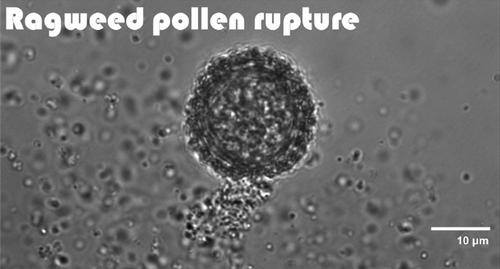Aerobiologia ( IF 2 ) Pub Date : 2021-05-05 , DOI: 10.1007/s10453-021-09702-x Elizabeth A. Stone , Chamari B. A. Mampage , Dagen D. Hughes , Lillian M. Jones

|
Ragweed pollen is a prevalent allergen in late summer and autumn, worsening seasonal allergic rhinitis and asthma symptoms. In the atmosphere, pollen can osmotically rupture to produce sub-pollen particles (SPP). Because of their smaller size, SPP can penetrate deeper into the respiratory tract than intact pollen grains and may trigger severe cases of asthma. Here we characterize airborne SPP forming from rupturing giant ragweed (Ambrosia trifida) pollen for the first time, using scanning electron microscopy and single-particle fluorescence spectroscopy. SPP ranged in diameter from 20 nm to 6.5 μm. Most SPP are capable of penetrating into the lower respiratory tract, with 82% of SPP < 1.0 μm, and are potential cloud condensation nuclei, with 50% of SPP < 0.20 μm. To support predictions of the health and environmental effects of SPP, we have developed a quantitative method to estimate the number of SPP generated per pollen grain (\({n}_{\mathrm{f}}\)) based upon the principle of mass conservation. We estimate that one giant ragweed pollen grain generates 1400 SPP across the observed size range. The new measurements and method presented herein support more accurate predictions of SPP occurrence, concentration, and air quality impacts that can help to reduce the health burden of allergic airway diseases.
Graphic abstract
Rupturing ragweed pollen releasing cellular components (right), viewed by an inverted light microscope.
中文翻译:

破破的豚草花粉破裂后产生的空中亚花粉颗粒
豚草花粉是夏末和秋季流行的过敏原,加剧了季节性变应性鼻炎和哮喘症状。在大气中,花粉可能会渗透破裂而产生亚花粉颗粒(SPP)。由于它们的尺寸较小,因此与完整的花粉粒相比,SPP可以更深地渗透到呼吸道,并可能引发严重的哮喘病例。在这里,我们描述了由豚草破裂(Ambrosia trifida)形成的空中SPP的特征。)首次使用扫描电子显微镜和单粒子荧光光谱法测定花粉。SPP的直径范围为20 nm至6.5μm。大多数SPP能够穿透下呼吸道,其中82%的SPP <1.0μm,并且具有潜在的云凝结核,其中50%的SPP <0.20μm。为了支持对SPP的健康和环境影响的预测,我们开发了一种定量方法来估计每个花粉粒产生的SPP数量(\({n} _ {\ mathrm {f}} \\))的原则。我们估计一种巨大的豚草花粉颗粒在观察到的大小范围内会产生1400 SPP。本文介绍的新测量方法和方法可支持SPP发生,浓度和空气质量影响的更准确预测,从而有助于减轻过敏性气道疾病的健康负担。
图形摘要
通过倒置光学显微镜观察,弄皱豚草花粉释放细胞成分(右)。


























 京公网安备 11010802027423号
京公网安备 11010802027423号